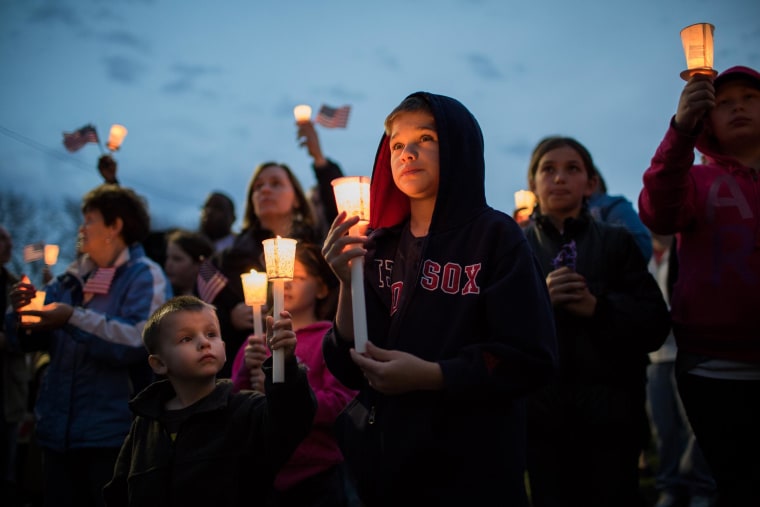A little more than a year after the Boston Marathon bombings and the five-day manhunt that terrorized Watertown neighborhoods, the impact of the ordeal on local children and teens may have been more far-reaching than anyone suspected.
About 11 percent of kids surveyed who were at the marathon finish line suffered from post-traumatic stress disorder, or PTSD, according to research conducted within the six months after the bombings, trauma experts say.
That’s about six times higher than the PTSD rate in kids who weren’t at the site of the April 15, 2013 attack that killed three people and injured 264, according to a study published Monday in the journal Pediatrics.
But in addition to such severe effects, researchers detected a range of other disturbing emotional and behavioral responses in kids who felt the impact of the manhunt close to home.
“There was an enormous mental health toll associated with direct exposure,” said Jonathan S. Comer, a child trauma expert who led the research. “And there also was a toll with kids exposed to the manhunt, which was an unfolding and uncontained situation that lasted much longer than the bombing itself.”
And much of the fallout was exacerbated in children exposed to the most TV coverage of the events, Comer found.
“Everyone in Boston has a story of what they did during the shelter-in-place request."
Nearly 1 million Boston-area residents were put under shelter-in-place orders in the days after twin pressure-cooker bombs exploded at the finish line of the popular marathon.
That included Comer, the father of a young child, who was director of the Early Childhood Interventions Program at Boston University at the time of the attack.
“Everyone in Boston has a story of what they did during the shelter-in-place request,” said Comer, now a professor of psychology and psychiatry at the Center for Children and Families at Florida International University in Miami.
He and his colleagues treated many of the kids from Watertown and the surrounding area and they wondered about the larger effects of the ordeal. Previous trauma research has focused on the aftermath of large-scale events such as 9/11, which were aimed at sites of “large symbolic value,” he said.
But what about an attack that hit so close to home that Boston-area kids heard gunshots in their own neighborhoods or had uniformed, armed police officers search their houses?
To answer that question, Comer reached out to schools, “Boston Strong” gatherings, local media and other venues to ask parents of affected kids to take a lengthy survey.
They ended up with 460 parents. They were asked to report and assess their children’s responses depending on a variety of factors, including whether they were at the marathon site, whether they were hurt, whether they witnessed injuries or dead bodies and whether they knew victims involved.
About half of the families who responded were affected by the shelter in place orders, but that alone didn’t induce likely PTSD, Comer noted.
Kids at the marathon site were most affected by PTSD. But kids exposed to the manhunt activities showed more signs of other problems, including emotional disturbances, acting-out behaviors, trouble with hyperactivity and paying attention and conflicts with peers.
“Our work shows that children’s reactions to such community problems is often more broad-based than PTSD,” Comer said.
Children in the survey watched an average of 1.5 hours of television coverage on the attack day; more than 20 percent of them watched more than three hours. “We were quite surprised and concerned that two-thirds of families didn’t make any attempt to control their child’s exposure to the coverage,” he said, noting that the best advice during such events is to turn off the TV.
“The majority of kids are resilient. A significant and considerable proportion of kids don’t do well and a smaller proportion of kids have problems for years.”
Overall, about 8 percent of kids in the survey reported total difficulties after the attacks. That squares with what Comer has experienced in his practice.
“The majority of kids are resilient,” Comer said. “A significant and considerable proportion of kids don’t do well and a smaller proportion of kids have problems for years.”
The study does not reflect results in the larger population after the Boston bombings, noted Merritt Schreiber, director of psychological programs in the Center for Disaster Medical Sciences at the University of California, Irvine, School of Medicine. Parents who chose to respond might have had kids who were more severely affected, for instance.
But the findings are consistent with other trauma research, including studies of kids affected by 9/11, said James Halpern, director of the Institute for Disaster Mental Health at the State University of New York Paltz. And they underscore the need to
“This article is a significant contribution to our understanding of the impact of terror attacks,” said Halpern, who was not involved in the research. “This study also reminds us that although children who are directly exposed are most at risk, we need to pay attention to children in the neighborhood, in nearby schools — those with less direct exposure.”
